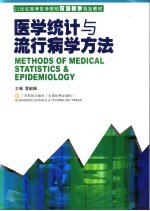

医学统计与流行病学方法PDF电子书下载
- 电子书积分:9 积分如何计算积分?
- 作 者:雷毅雄主编
- 出 版 社:广州:广东科技出版社
- 出版年份:2006
- ISBN:7535940544
- 页数:197 页
Part Ⅰ Medical statistics 1
Chapter 1 Introduction of Medical Statistics 1
1.Definition of Statistics 1
2.Statistics and Medicine 1
3.Basic Contents 2
4.Basic Concepts 2
5.Types of Data 4
6.Steps of Statistical Work 4
7.Methods of Study for Medical Students 4
Chapter 2 Description of Measurement Data 5
1.Distribution of Frequency 5
2.Average 6
3.Measures of Spread or Dispersion 10
4.Normal Distribution and Applications 13
2.Student t-distribution 20
1.Sampling Error and Standard Error 20
Chapter 3 Inference of Measurement Data 20
3.Confidence Interval of Population Mean 21
4.Hypothesis Testing of Population Mean 22
5.t-test and u-test 23
6.Type Ⅰ Error and Type Ⅱ Error 26
7.Attention in the Hypothesis Testing 26
Chapter 4 Analysis of Variance(ANOVA) 28
1.Complete Randomized Design One-way ANOVA 29
2.Post Hoc Comparisons 32
3.Randomized Block Design ANOVA 33
Chapter 5 Description of Enumeration Data 36
1.Relative Number 36
2.Cautions in the Use of Relative Number 36
3.Standardization of Rate 37
1.Sampling Error of Proportion 41
2.Confidence Interval of Population Proportion 41
Chapter 6 Inference of Enumeration Data 41
3.Hypothesis Testing of Proportion(u-test) 42
4.Chi-square Test(x2-test) 43
5.Cautions in Chi-square Test for R×C Table 48
Chapter 7 Linear Correlation and Regression 50
1.Linear Correlation Analysis 50
2.Linear Regression analysis 54
3.Cautions of Correlation and Regression Analysises 55
Chapter 8 Statistical Tables and Graphs 57
1.Principles of Making Tables and Graphs 57
2.Common Statistical Tables 57
3.Common Statistical Graphs 58
Part Ⅱ Method of Epidemiology 63
Chapter 1 An Introduction to Epidemiology 63
1.A Brief History of Epidemiology 63
2.Epidemiology Definition and Explanation 65
3.Methods in Epidemiological Studies 66
4.The Scope and Objectives of Epidemiology 69
Chapter 2 Distribution of Disease 71
1.Three Patterns of Distribution 71
2.Measures of Disease Frequency 83
3.Patterns of Spread of a Disease 87
Chapter 3 Cross-sectional Studies 89
1.What is a Cross-sectional Study? 89
4.Category of Cross-sectional Studies 90
3 Uses of Cross-sectional Studies 90
2.Charaterestics of Cross-sectional Studies 90
5.Design of Cross-sectional Studies 95
6.Advantages and Disadvantage of Cross-sectional Studies 95
7.Overview of Questionnaire Design 95
Chapter 4 Case-Control Studies 100
1.Definition of Case-control Study 100
2.Charaterestics of Case-control Studies 101
3.Design of Case-control Studies 101
4.Advantages and Disadvantage of Case-control Studies 107
1.Definition of Cohort Studies 110
Chapter 5 Cohort Studies 110
2.Charaterestics of Cohort Studies 111
3.Types of Cohort Studies 111
4.Design of Cohort Studies 111
5.Analysis of Cohort Studies 113
6.Advantages and Disadvantages of Cohort Studies 117
Chapter 6 Experimental Studies 118
1.Definition of Experimental Studies 118
2.Characters of Experimental Studies 118
3.Types of Experimental Studies 118
4.Clinical Trials 119
1.History of Cause of Diseases 125
2.Concept of Cause 125
Chapter 7 Causes and Causal Inference 125
3.Types of Causes 126
4.The Epidemiological Process of Ascertaining the Cause 126
5.Criteria for Causation 129
6.Bias 130
Part Ⅲ 流行病学方法 135
第一章 流行病学简介 135
一、流行病学简史 135
二、流行病学概念 136
三、流行病学方法 137
四、流行病学研究的范围与目的 138
第二章 疾病的分布 141
一、疾病的三间分布 141
二、疾病频率的测量 150
三、疾病流行强度 153
二、现况调查的用途和目的 154
三、现况调查的种类 154
一、现况调查的概念与特征 154
第三章 现况调查 154
四、现况调查的局限性 158
五、现况调查研究设计要点 158
第四章 病例对照研究 161
一、病例对照研究的定义 161
二、病例对照研究的特征 161
三、病例对照研究设计与分析 161
四、病例对照研究优缺点 166
第五章 队列研究 168
一、队列研究的定义 168
二、队列研究的特征 168
三、队列研究的种类 168
四、队列研究的设计 169
五、队列研究资料的分析 171
六、队列研究的优缺点 175
一、概述 176
第六章 流行病学实验研究 176
二、临床实验 178
三、临床实验的基本原则 180
四、流行病学实验应注意的伦理道德问题 182
五、流行病学实验的优缺点 182
第七章 病因及病因推断 184
一、病因的概念 184
二、病因概念的发展 184
三、病因分类 185
四、流行病学研究病因的方法 186
五、确定病因与疾病因果关联的标准 188
Appendix 1 Critical values of t 191
Appendix 2.1 Critical values of F(for analysis of variance) 192
Appendix 2.2 Critical values of F(for analysis of variance) 193
Appendix 2.3 Critical values of F(for analysis of variance) 194
Appendix 2.4 Critical values of F(for analysis of variance) 195
Appendix 3 Critical values of q(for Newman-Keuls) 196
Bibliography 197
- 《建筑施工企业统计》杨淑芝主编 2008
- 《大国医 30位国宝级“国医大师”的养生绝活》秦泉主编 2016
- 《流行手风琴曲集》仲凯编著 2019
- 《中国农村经营管理统计年报(2015年)》农业部农村经济体制与经营管理司,农业部农村合作经济经营管理总站编 2016
- 《概率论与数理统计》傅丽芳 2018
- 《小荧星艺术学校通用教程 流行舞初级教程》沈莹 2019
- 《大国医 脾胃调和百病消》路志正,路京华 2018
- 《流行音乐产业的符号学研究》刘小波著 2019
- 《牙髓病学 生物学与临床视角》(意)多米尼科·里库奇,(巴西)小约瑟·斯奎拉编;陈刚,殷欣,苏阳责编;刘贺,汪林译 2020
- 《中国流行音乐的历史演变与多元化风格探析》刘迪责编;赵亮 2020
- 《中国十大出版家》王震,贺越明著 1991
- 《近代民营出版机构的英语函授教育 以“商务、中华、开明”函授学校为个案 1915年-1946年版》丁伟 2017
- 《科技语篇翻译教程》雷晓峰,李静主编 2020
- 《二十世纪广东包装设计史》王娟著 2019
- 《国之重器出版工程 云化虚拟现实技术与应用》熊华平 2019
- 《新闻出版博物馆 总第33期》新闻出版博物馆 2018
- 《上海市订购外国和港台科技期刊联合目录 1983 上》上海科学技术情报研究所 1983
- 《生物科技、医学与法律》齐延平,安·玛丽·杜盖著 2018
- 《科技新闻英语 英汉互译精选》郑佩芸主编;吴越,郭亮,毛隽副主编 2019
- 《科技法教程》李功国著 1993
